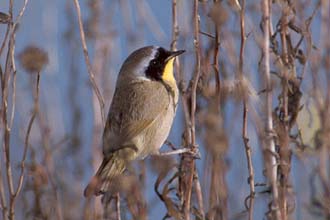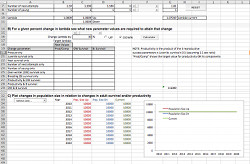Helping Managers Assess Vulnerability of Tidal Marsh Birds to Climate Change
| In the project Vulnerability Analysis and Monitoring Program for Detecting Changes in San Francisco Bay Tidal Marsh Bird Populations researchers at PRBO Conservation Science developed the population-dynamic models needed in addition to habitat change projections to assess vulnerability of four tidal marsh-dependent species in the San Francisco Estuary: California Black Rail, California Clapper Rail, Saltmarsh Common Yellowthroat, and three tidal marsh-dependent subspecies of Song Sparrow; all species are California Threatened, Federally Endangered, or California Species of Special Concern. The researchers have made project results useful to managers to guide decision-making and prioritize potential management actions through a technical report summarizing findings and by creating a spreadsheet-based tool. | |
 Above: Common Yellowthroat  The Simple Population Dynamic Model Tool makes it easy to explore a variety of potential outcomes for four tidal marsh-bird species. Get it here. |
Results of the project: The project included development of two types of models:
A technical report describes how the models were created, how to use them, and relevant findings. A framework for monitoring impacts of climate change on tidal marsh birds will be completed in June 2013. The interactive spreadsheet tool enables managers to (1) better understand the sensitivity of changes in population trend and viability in relation to changes in demographic parameters, including survival and reproductive success, and (2) evaluate the efficacy of proposed management actions to counteract threats to long-term viability for the four tidal marsh species studied. |
|
Some Key Findings of the Population Dynamics Modeling Study:
|
|
| How Can I Use The Simple Population Dynamics Tool? This spreadsheet tool was created to enable managers to better understand the sensitivity of population trends to changes in the underlying vital rates, and how population trend can be altered in relation to potential management actions or environmental change. A set of instructions is included in the top worksheet of the file, explaining how to use the spreadsheet in one of three ways:
For help applying this tool and the results of the study to conservation planning, please contact Nadav Nur at nnur@prbo.org |
|
5/2015
